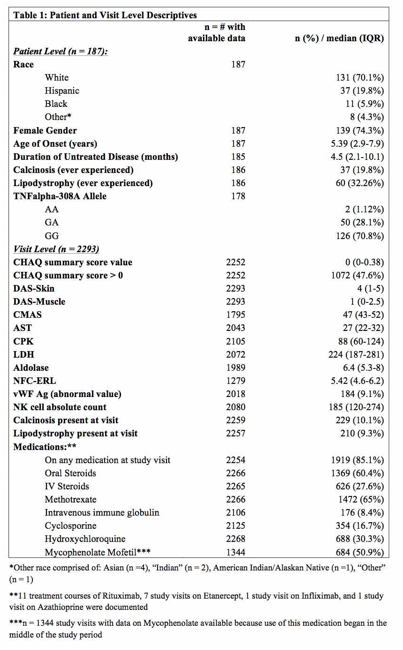Session Information
Date: Monday, November 6, 2017
Session Type: ACR Poster Session B
Session Time: 9:00AM-11:00AM
Background/Purpose:
Juvenile myositis (JM) is marked by skin rashes, proximal muscle weakness, and deconditioning causing potentially severe disability. Studies examining long-term physical function in JM remain scant. This study aims to define longitudinal predictors of physical function in JM.
Methods:
JM patient data collected prospectively at routine clinic visits from January 2000 to June 2014 at Ann & Robert H. Lurie ChildrenÕs Hospital of Chicago was used in this study. Only patient visits with documented Childhood Health Assessment Questionnaire (CHAQ) summary scores were included for analysis. Demographic/clinical variables were extracted, including: gender, race, duration of untreated disease, Disease Activity Score (DAS) – muscle/skin domains, Childhood Myositis Assessment Scale (CMAS), muscle enzymes (i.e. CPK, AST, LDH, aldolase), nailfold capillary end row loops (NFC-ERL), von Willebrand factor antigen (vWFAg), calcinosis, lipodystrophy, possible markers of disease severity (i.e. NK cell absolute counts, TNFalpha-308A allele), and treatments. Descriptive statistics were calculated. CHAQ was dichotomized (0 vs. >0) as most scores equaled zero. Generalized estimating equations for binary data specifying logit link function were used to evaluate effects for each covariate with a main effect for time. Covariates were univariably analyzed at p < 0.10, with all univariably significant covariates entered into a multivariable model for CHAQ > 0 using a manual backward selection method.
Results:
Table 1 describes the study sample (i.e. n = 187 patients with 2293 study visits and median follow-up 3.58 years). The following univariably significant covariates (at p < 0.10) were included in the multivariable model: time (years from visit 0) (p <0.0001), black race (p = 0.035), DAS-skin (p = 0.006), DAS-muscle (p <0.0001), CMAS (p <0.0001), LDH (p = 0.005), aldolase (p = 0.013), NFC-ERL (p = 0.002), abnormal vWFAg (p = 0.0001), lipodystrophy (p <0.0001), cyclosporine (p = 0.0725), and IV solumedrol (p = 0.0002). Complete data for the multivariable model was available for 892 study visits from all 187 unique patients. Significant adjusted associations persisted in the multivariable model for CMAS (OR: 0.91, p <0.0001), aldolase (OR: 1.1, p = 0.0024), and lipodystrophy (OR: 2.2, p = 0.0126), with a trend towards significance for NFC-ERL (OR: 0.84, p = 0.0502).
Conclusion:
To our knowledge, this is the largest longitudinal study of prospectively collected physical function data yet reported in JM. Measures of muscle weakness/inflammation (i.e. CMAS, aldolase) predict long-term physical function. The relationships between lipodystrophy, vasculopathy (i.e. NFC-ERL), and physical function warrant closer attention and replication.
To cite this abstract in AMA style:
Ardalan K, Palac HL, Lee J, Wolfe M, Morgan GA, Pachman LM. Longitudinal Predictors of Physical Function in Juvenile Myositis [abstract]. Arthritis Rheumatol. 2017; 69 (suppl 10). https://acrabstracts.org/abstract/longitudinal-predictors-of-physical-function-in-juvenile-myositis/. Accessed .« Back to 2017 ACR/ARHP Annual Meeting
ACR Meeting Abstracts - https://acrabstracts.org/abstract/longitudinal-predictors-of-physical-function-in-juvenile-myositis/

